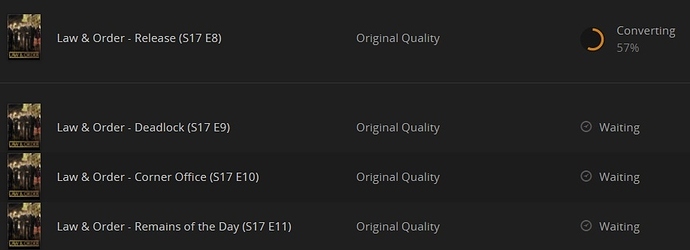@MovieFan.Plex’s point is easy to understand when you figure out how transcoding works.
First off, there’s a switch in the settings that determines how far ahead the transcoder will try to stay in front of the video that is currently streaming. This is found at Settings > Transcoder > Transcoder default throttle buffer.
It’s used to tell Plex how many seconds in advance you want Plex to transcode, in relation to the current playback spot. (sort of.) What really happens is the client requests the next “block” and the server transcodes the next block or two + the time in this setting to stay ahead of your playing.
While you are watching ANYTHING that requires transcoding, until the stream is done, the transcoder is “tied” up or in use. At least this has been my experiences with it and the OM feature. The only time the transcoder isn’t considered in use, is when you Direct Play something while you are streaming. Then the OM feature can make as many files as it can, until you start transcoding a different video again.
There isn’t really an easy way to get around all of this, if your media is stored in file containers or codecs that will require transcoding on some or all of your clients. Short of doing a conversion outside of Plex itself, as long as you have a stream open which requires transcoding, then the OM versions can’t be made, whether the transcoder is actually running on the media or not. (At least that has been my personal observations on my own media.)
Conversion scripts, apps like HandBrake or similar can be used to do conversions as well as the built in OM feature, and are likely to produce a higher quality conversion. They are going to require more efforts on your part to make sure it all happens. But the quality differences are worth the efforts to get things set up IMO.
I personally use @cayars conversion scripts on any media I have prior to adding it to a Plex library. The reason is pretty simple, actually… The media starts its life in my library already in the best format available to Direct Play. Now the only times my server transcodes is when the stored bitrate is higher than the client is set to, the levels are not 4.0 or 4.1, or I have something set up wrong on a client app.
Also keep in mind that even though PlexPy is using the API for getting most of its data from the server, it’s not always showing something exactly as it is on the server. It does a pretty good job, but it’s not 100%. Until more calls for the API are added, the best PlexPy can do on some things is an educated guess. And it’s been my experience that the transcode bar on the playing stream is one of those “educated guess” situations. Until PlexPy is built into PMS and the Web App itself, or until more calls are made in the API, this is the best you can expect from a 3rd party tool.
Don’t get me wrong! This tool is GREAT for the historical information it provides ALONE! But it’s not going to give you the information that Plex itself could give, if the Web App had the interface to allow this type of reporting.
If all of this is still “unacceptable” well, I’m sorry. There is always a difference between expectations and reality. And the reality is, this is what we have. What we all want is something built by the Plex Team, using Plex’s own tools built into the Plex Web App itself. Until we get that, we have to face it, we gets what we gets.










